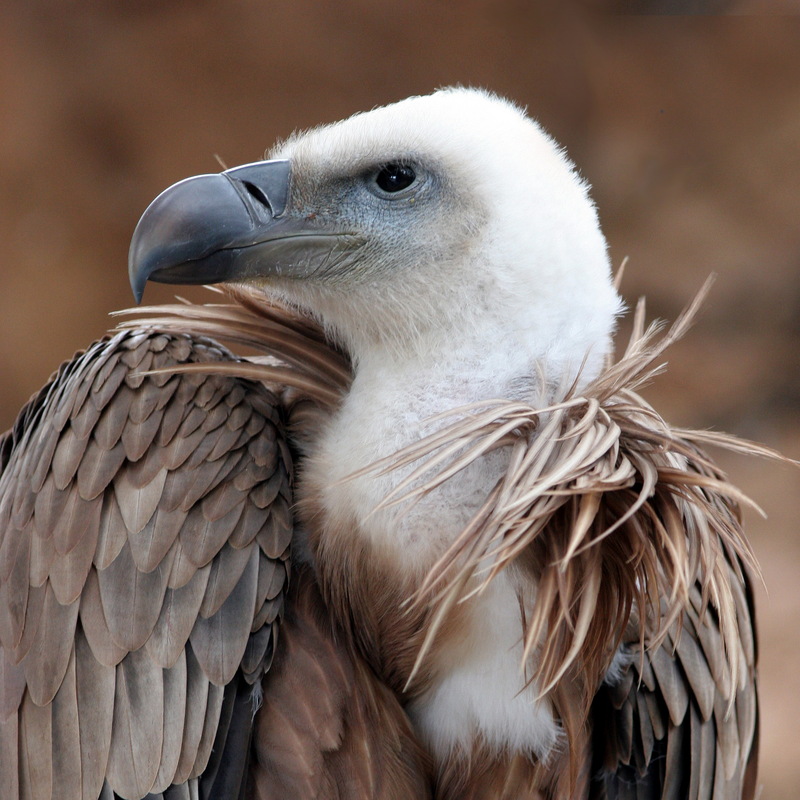|
| Query: anthrax anthrax | Result: 4th of 6 | |
Vulture (Falconiformes Accipitridae (part); Ciconiiformes Cathartidae) - Wiki
| Subject: | Vulture (Falconiformes Accipitridae (part); Ciconiiformes Cathartidae) - Wiki
| |

| Resolution: 2336x2336
File Size: 1883147 Bytes
Date: 2007:10:28 17:24:14
Upload Date: 2007:10:28 17:28:32
|
Vulture
From Wikipedia, the free encyclopedia
[Photo] Griffon vulture, Gyps fulvus beak. Photographer: Thermos.
Vultures are scavenging birds, feeding mostly on the carcasses of dead animals. Vultures are found in every continent except Antarctica and Oceania.
A particular characteristic of many vultures is a bald head, devoid of feathers. This is likely because a feathered head would become spattered with blood and other fluids, and thus be difficult to keep clean.
A group of vultures is occasionally called a venue in literature. When circling in the air, a group of vultures is called a kettle. The German word Geier does not have a precise meaning in ornithology, and is sometimes used to refer to a vulture in English, as in some poetry.
Classification
Vultures are classified into two groups: Old World vultures and New World vultures. The similarities between the two different groups are due to convergent evolution.
Old World vultures
The Old World vultures found in Africa, Asia and Europe belong to the family Accipitridae, which also includes eagles, kites, buzzards and hawks. Old World vultures find carcasses exclusively by sight.
New World vultures
The New World vultures and condors found in warm and temperate areas of the Americas are not closely related to the superficially similar Accipitridae, but belong in the family Cathartidae, which is quite close to the storks. Several species have a good sense of smell, unusual for raptors.
Feeding
Vultures seldom attack healthy animals, but may kill the wounded or sick. Vast numbers have been seen upon battlefields. They gorge themselves when prey is abundant, till their crop bulges, and sit, sleepy or half torpid, to digest their food. They do not carry food to their young in their claws, but disgorge it from the crop. These birds are of great value as scavengers, especially in hot regions. They can eat rotten flesh containing anthrax, botulism, and cholera bacteria, which are destroyed in the stomach.
Threat due to diclofenac poisoning
The vulture population in India and Pakistan has declined by up to 95% recently in the past decade, and two or three of the species of vulture in South Asia are nearing extinction. This has been caused by the practice of giving working farm animals diclofenac, which is a non-steroidal anti-inflammatory drug (NSAID) with anti-inflammatory and pain killing actions. Diclofenac administration keeps animals that are ill or in pain working on the land for longer, but, if the ill animals die, their carcasses contain diclofenac. Farmers leave the dead animals out in the open, relying on vultures to tidy up. Diclofenac present in carcass flesh is eaten by the vultures, which are sensitive to diclofenac, suffering kidney failure, visceral gout, and death as a result of diclofenac poisoning.
The decline in vultures has led to hygiene problems in India as carcasses of dead animals now tend to rot, or be eaten by rats or wild dogs, rather than be tidied up by vultures. Rabies among these scavengers is a major health threat. India has the world's highest rate of rabies.
The decline in vultures causes particular problems for certain communities, such as the Parsi, who practice sky burials, where the human dead are put on the top of Towers of Silence and are eaten by vultures, leaving only dry bones.
Meloxicam (another NSAID) has been found to be harmless to vultures and should prove an acceptable alternative to diclofenac. The Government of India banned diclofenac, but it continues to be sold over a year later and is still a problem in other parts of the world.
http://en.wikipedia.org/wiki/Vulture
| The text in this page is based on the copyrighted Wikipedia article shown in above URL. It is used under the GNU Free Documentation License. You may redistribute it, verbatim or modified, providing that you comply with the terms of the GFDL. |
|
Comments |
|---|
| | Guest |
|
| The griffon vulture (Gyps fulvus) is a large Old World vulture in the bird of prey family Accipitridae. It is also known as the Eurasian griffon. It is not to be confused with a different species, Rüppell's griffon vulture (Gyps rueppellii). Order: Accipitriformes, Family: Accipitridae, Subfamily: Aegypiinae, Binomial name: Gyps fulvus (Hablizl, 1783). |
| | Guest |
|
Scientific Name: Gyps fulvus (Hablizl, 1783)
Common Names: Griffon Vulture, Eurasian Griffon, Eurasian Griffon Vulture
French: Vautour fauve; German: Gänsegeier; Spanish: Buitre leonado
Taxonomy: Vultur fulvus Hablizl, 1783, Samamisian Alps, Gilan, Iran. |
^o^
Animal Pictures Archive for smart phones
^o^
|
|
|

